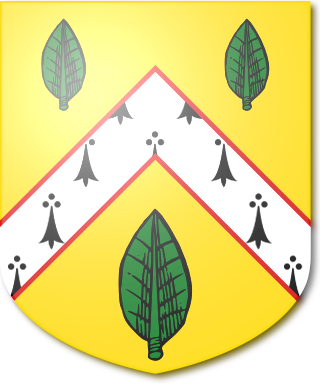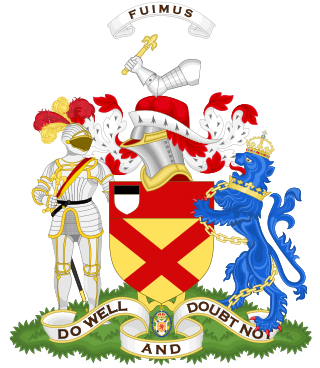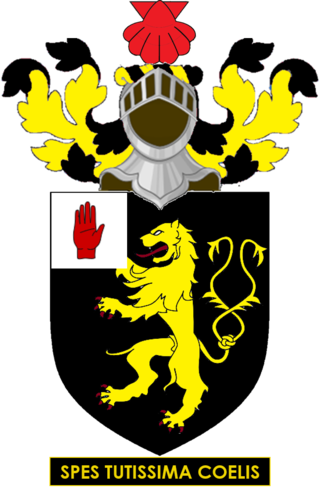
The Eliott Baronetcy, of Stobs in the County of Roxburgh, is a title in the Baronetage of Nova Scotia. It was created on 3 December 1666 for Gilbert Eliott. The second baronet was a member of the pre-union Parliament of Scotland. The third Baronet sat as Member of Parliament for Roxburghshire. The Eliott Baronets share a common early Elliot ancestry with the nearby Earls of Minto (Elliot). It is thought that the surname spelling differences were contrived to differentiate the branches.
There have been two baronetcies created for persons with the surname Aykroyd, both in the Baronetage of the United Kingdom for members of the same family.

The Anson baronetcy, of Birch Hall in the County Palatine of Lancaster, is a title in the Baronetage of the United Kingdom held by a branch of the Anson family.

The Hammick Baronetcy, of Cavendish Square, London, is a title in the Baronetage of the United Kingdom. It was created on 25 July 1834 for the noted surgeon and physician Stephen Hammick.

The Couper Baronetcy is a title in the Baronetage of the United Kingdom. It was created on 23 June 1841 for George Couper. He was a colonel in the Army and fought in the Peninsular War, served as Military Secretary to the Governor Generals of Canada, Sir James Kempt and Lord Durham, and was Comptroller of the Household and Equerry to Her Royal Highness the Duchess of Kent. The second Baronet was an administrator in India and served as Governor of the North-West Provinces between 1877 and 1882. Another member of the family to gain distinction was James Kempt Couper, second son of the first Baronet. He was a general in the Army.

The Muir Mackenzie Baronetcy, of Delvine in the County of Perth, is a title in the Baronetage of the United Kingdom. It was created on 9 November 1805 for Alexander Muir Mackenzie. Born Alexander Muir, he had assumed the additional surname of Mackenzie on succeeding to the estates of his great-uncle John Mackenzie, of Delvine, Perthshire, third son of Sir Kenneth Mackenzie, 1st Baronet, of Coul.

The Pigot Baronetcy, of Patshull Hall in the County of Stafford, is a title in the Baronetage of Great Britain. It was created on 5 December 1764 for the politician and colonial administrator George Pigot, with remainder to his brothers General Robert Pigot and Admiral Hugh Pigot, and remains extant. On 19 January 1766 Pigot was further honoured when he was raised to the Peerage of Ireland as Baron Pigot, with normal remainder to the heirs male of his body. Lord Pigot was unmarried and on his death in 1777 the barony became extinct. He was succeeded in the baronetcy according to the special remainder by his brother, Robert, the second Baronet. He was a distinguished soldier.
There have been two baronetcies created for persons with the surname Gibbons, one in the Baronetage of Great Britain and one in the Baronetage of the United Kingdom. One creation is extant as of 2012.

The Elton Baronetcy, of Bristol, is a title in the Baronetage of Great Britain. It was created on 31 October 1717 for Abraham Elton, Mayor of and Member of Parliament for Bristol from 1722 to 1727. The second Baronet was also Mayor of Bristol and represented Taunton and Bristol (1727–1742) in the House of Commons. The seventh Baronet sat as Liberal Member of Parliament for Bath. The eighth Baronet was High Sheriff of Somerset in 1895. The tenth Baronet was a pioneer of the British documentary film industry.

Colonel Sir Charles Rosdew Forbes-Leith, 1st Baronet, known as Charles Burn until 1923 and as Sir Charles Burn, Bt, between 1923 and 1925, was a British army officer and Conservative Party politician who was Member of Parliament for Torquay from 1910 to 1923.

Alexander John Forbes-Leith, 1st Baron Leith of Fyvie JP, DL, was a Scottish Royal Navy officer and US steel magnate.
Sir Robert Ian Algernon Forbes-Leith, 2nd Baronet KT MBE was a Scottish landowner and soldier who served as Lord Lieutenant of Aberdeenshire.

The Bruce Baronetcy, of Stenhouse in the County of Clackmannan, was created in the Baronetage of Nova Scotia on 29 September 1628 for William Bruce, with remainder to his heirs male whatsoever. He was a descendant of Sir Robert Bruce of Clackmannan, who was also the ancestor of the ancestor of the Earls of Elgin. The eleventh Baronet was an author and adventurer.

The Campbell baronetcy, of Barcaldine in the County of Argyll and of Glenure, was created in the Baronetage of the United Kingdom on 30 September 1831 for the soldier Duncan Campbell.

The Russell baronetcy, of Swallowfield in the County of Berkshire, was created in the Baronetage of the United Kingdom on 10 December 1812 for Henry Russell. He was Chief Justice of Bengal and was admitted to the Privy Council in 1816. The 3rd Baronet represented Berkshire and Westminster in the House of Commons as a Conservative and was also awarded the Victoria Cross. The 4th Baronet sat as a Conservative Member of Parliament for East Berkshire. The 6th Baronet was a noted mineralogist.

The Russell baronetcy, of Littleworth Corner, Burnham in the County of Buckingham, was created in the Baronetage of the United Kingdom on 18 January 1916 for Charles Russell, a senior partner in the firm of Charles Russell & Co., solicitors. The baronetcy was created with remainder, failing heirs male of the grantee, to the heirs male of his father.<

The King baronetcy, of Charlestown in the County of Roscommon, was created in the Baronetage of the United Kingdom on 1 July 1815 for Gilbert King, son of Gilbert King (1710–1788), Member of the Irish Parliament for Jamestown, and a direct descendant of Edward King, Bishop of Elphin.
The Forbes baronetcy, of Pitsligo and Monymusk in the County of Aberdeen, was created in the Baronetage of Nova Scotia on 30 March 1626 for William Forbes, with remainder to heirs male whatsoever. He was a descendant of Duncan Forbes, second son of James Forbes, 2nd Lord Forbes.

The Forbes baronetcy, of Craigievar in the County of Aberdeen, was created in the Baronetage of Nova Scotia on 20 April 1630 for William Forbes, son of the merchant William Forbes who built Craigievar Castle. He was also a descendant of Hon. Patrick Forbes, third son of the 2nd Lord Forbes, and the nephew of the 1st Baronet of the 1628 creation.

The Forbes baronetcy, of Newe in the County of Aberdeen, was created in the Baronetage of the United Kingdom on 4 November 1823 for Charles Forbes, a merchant in Bombay, India. He was a Member of Parliament for Beverley and then Malmesbury.